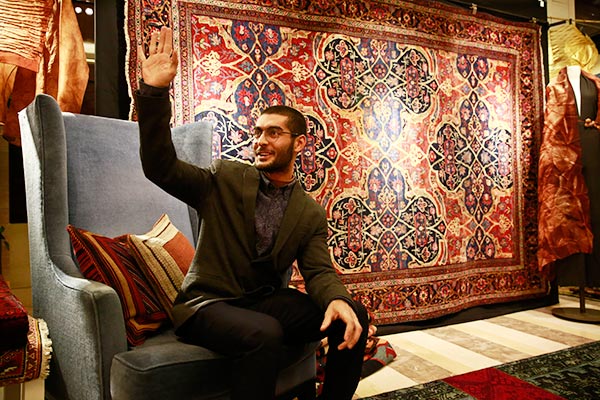
Matin Zamani displays his collection of handmade Persian rugs at Beijing's Four Seasons hotel. (Photo: China Daily/Feng Yongbin)
Swirls of electric blue leap off the finely knotted silk, affirming that the intricate design was handcrafted in Esfahan, Iran.
Indigo, a plant extract, produces the distinctive color today as it has for Persian weavers for centuries, while another vegetable dye, saffron, delivers an equally powerful golden yellow to the door-sized carpet that hangs in front of Matin Zamani.
As a passer-by caresses the rug displayed in the lobby of a Beijing hotel, the soft-spoken Iranian importer smiles and agrees it's a work of art, well worth the 40,000 yuan ($6,150) price tag.
"But these kinds of 'city rugs' are not really my favorites," says Zamani, 26.
He prefers the tribal pieces-preferably from tiny Baluchi or Kurdish villages-that weavers create extemporaneously instead of from a pattern.
His own family comes from the ancient city of Tabriz, where "at least one in every four people is in the rug business", says Zamani.
His grandfather made money in commercial carpets, but was always on the lookout for handmade artisan rugs and he amassed a huge collection, "like 10,000 of them, mostly bought in small places".
When Zamani was just a boy, his father took the family from Tabriz to Malaysia and built a real estate business there. Zamani struck out farther, coming to China after winning a design scholarship in Shanghai. While that didn't feel like a perfect fit, his artistic side blossomed and he developed a new appreciation of traditional rugs, which he'd taken for granted much of his life.
"I saw that there were a lot of cheap rugs and copies of Persian rugs in China," he says. "But I became convinced that I could make people appreciate the real things."
He reaches for a rug made in Hariz, a remote village of about 7,000 people, which has a particular style that's based in pattern and geography.
"The soil is high in copper, which affects the chemical composition of the grass, which affects the chemical composition of the wool-it's very shiny and high fat.
"Because they are distinctive and rare, these rugs are really sought-after," he says. "John Kerry (US Secretary of State) is a big collector of these."
Zamani's romance with traditional rug making is tinged with the realities of modern life, which will inevitably lead to change.
"A 16-year-old girl who is weaving rugs in a small village has Instagram now," he says, chuckling. "She may be posting her progress every time she adds 5 centimeters to a design, and a collector in New York decides he likes it."
A generation ago, Zamani adds, such a girl would never travel more than a few kilometers from her village, let alone have the outside world come to her.
"Now, there is access to the Internet, to books and other things, and so design motifs don't stay isolated as much as they once did."
But handcrafted, naturally dyed rugs have their own character, and inconsistencies in the colors and patterns make each piece unique-a collectable artwork whether it's hung on the wall or spread on the floor. Surprisingly, natural dyes last longer than the chemical colors used in machine-made rugs, which Zamani says can start washing out after a year's wear.


















































